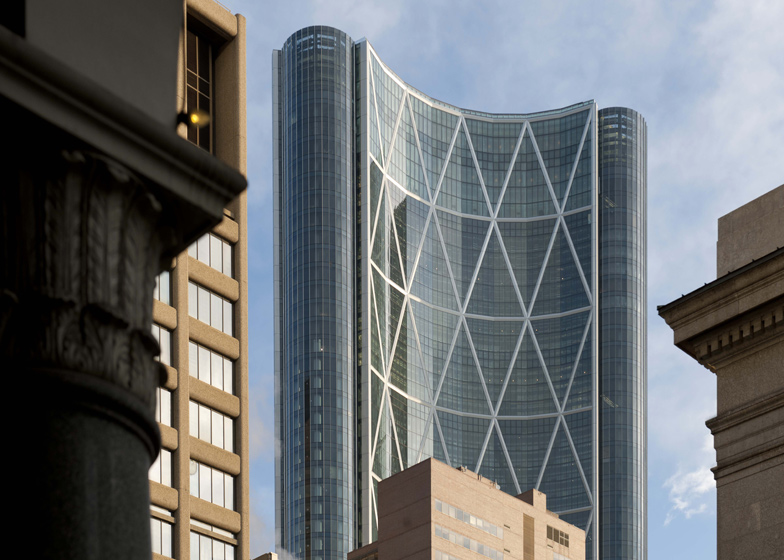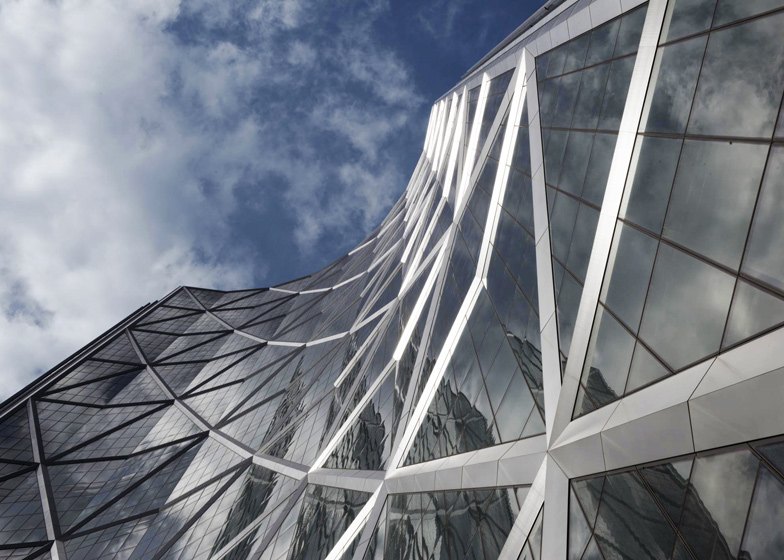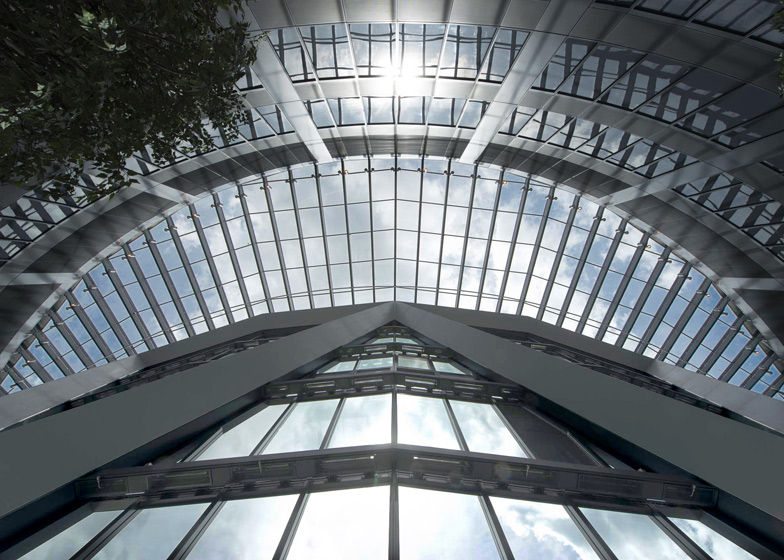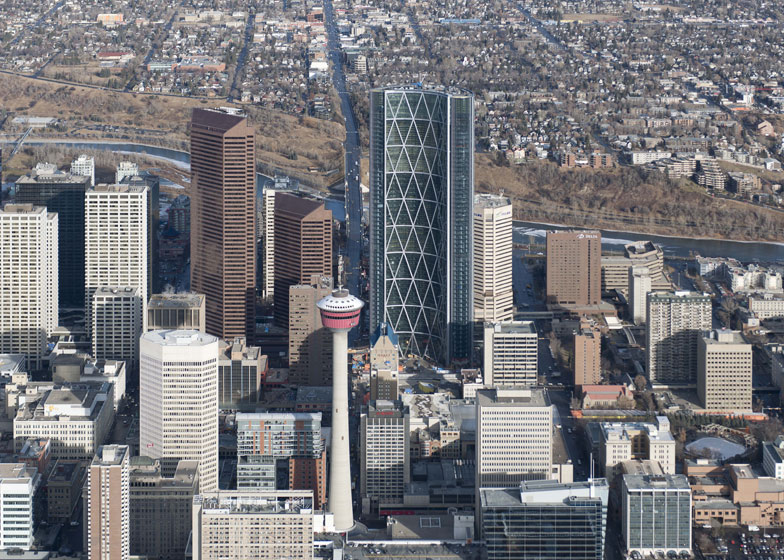Foster + Partners has completed a 58-storey bowed tower in Calgary, Canada (+ slideshow).
At 247 metres, The Bow is the tallest building in the city, and the tallest tower in Canada outside of Toronto.
Climate analysis helped to determine the form of the tower, with a concave facade on the south side facing the sun and a convex surface reducing the load of prevailing winds on the other side.
A triangulated grid structure with sections spanning six storeys braces the building and helps to reduce the visual mass of the surfaces. "Every aspect, from the raised floors to the diagrid structure, is designed to be highly efficient," says Nigel Dancey, a senior partner at Foster + Partners.
A series of atria occupy the space behind the concave facade, helping to insulate the building and reduce energy consumption.
Three skygardens projecting into the atria provide social spaces for staff in the offices that occupy the building, featuring mature trees, meeting rooms, catering facilities and lifts.
A system of enclosed walkways links The Bow, which is located in the city's downtown district, to the surrounding buildings so locals can avoid the harsh winter climate.
On the ground level, a publicly accessible space contains shops, restaurants and cafes.
Foster + Partners is working on two residential skyscrapers for a mixed-use development in north London and a riverside development in Lambeth featuring three towers of different heights – see all architecture by Foster + Partners.
Photography is by Nigel Young.
Here's some more information from the architects:
Official opening of The Bow, Calgary’s tallest tower
Special events have been held in Calgary this week to mark the official opening of The Bow, a 237- metre-high headquarters tower – the city’s tallest building and Canada’s tallest tower outside Toronto.
A bold new landmark on the skyline, the project is equally significant in urban, social and environmental terms: the public base of the tower is filled with shops, restaurants and cafes and extends into a generous landscaped plaza, while the office floors are punctuated by three six-storey sky gardens, which encourage natural ventilation and help to significantly reduce energy use.
The Bow is the first major development on the east side of Centre Street, a major axis through downtown Calgary, and it provides a shared headquarters for Encana and Cenovus.
The building’s form was shaped by analysis of the climate and organisations. The tower faces south, curving towards the sun to take advantage of daylight and heat, while maximising the perimeter for cellular offices with views of the Rocky Mountains. By turning the convex facade into the prevailing wind, the structural loading is minimised, thus reducing the amount of steel required for the inherently efficient diagrid system.
Each triangulated section of the structure spans six storeys, helping to visually break down the scale of the building.
Where the building curves inwards, the glazed facade is pulled forward to create a series of atria that run the full height of the tower. These spaces act as climatic buffer zones, insulating the building and helping to significantly reduce energy consumption. As each floor plate has been sized to accommodate a whole business unit, there was a need to promote collaboration across the companies and bring a social dimension to the office spaces.
Vertical access to the office floors is therefore directed through three spectacular sky gardens, which project into the atria at levels 24, 42 and 54 and incorporate mature trees, seating, meeting rooms, catering facilities and local lift cores. Staff facilities in these atria are complemented by an auditorium at the very top of the building.
The Bow also establishes lateral connections with surrounding buildings. The tower is fused at two points to Calgary’s system of enclosed walkways, which offers a retreat from the city’s harsh winters.
The second floor is open to the public and integrates shops and cafes, and with the only public connection over Centre Street, the scheme completes a vital pedestrian link in the downtown network. Externally, the building’s arc defines a large landscaped public plaza, at the heart of which is a landmark sculpture by Spanish artist, Jaume Plensa.
Nigel Dancey, Senior Partner, Foster + Partners: “The tower’s form was shaped by the unique Calgary climate – facing south, the building curves to define a series of spectacular light-filled six-storey atria, with mature sky gardens, cafes and meeting areas, which bring a vital social dimension to the office floors. This principle extends to the base of the tower, which is highly permeable, with a +15 enclosed bridge connection to downtown, an atrium of shops and cafes and a fantastic new plaza. Every aspect, from the raised floors to the diagrid structure, is designed to be highly efficient. The Bow is a bold new symbol for Calgary, and is testament to the strength of our team and excellent local relationships.”
The Bow, EnCana and Cenovus Headquarters
Calgary, Canada 2005 – 2013
Client: H+R Real Estate Investment Trust
Appointment: 2005
Construction Start: 2007
Completion: 2013
Site area: 17,500m2 / 188,300ft2
Area (gross external): 199,781m2 / 2,149,644ft2
Typical Floor Area (net): 3,584m2 / 38,564ft2
Height: 236m / 774.3ft
Number of Floors: 58
Structure: Steel-braced moment frame with a diagrid
Capacity: 4000
Facilities: Offices, Public plaza, Retail facilities
Parking facilities: 1360 car spaces
Materials: 39,000 tonnes of steel was used; 900,000ft2 of glass was used
Sustainability: The building’s form deflects the prevailing winds, allowing for a lighter structure
The solar heat collected in the atrium is redistributed throughout the year by means of extraction during winter and heat exchange during summer, reducing the load on the mechanical systems
3 x 6 storey-high “Sky gardens” with natural vegetation at levels 24, 42 and 54
Large glazed areas reduce the need for artificial lighting Heat redistribution system
Displacement ventilation via a raised floor
Client: H+R Real Estate Investment Trust
Tenant: Encana and Cenovus
Developer: Matthews Southwest Developments
Architect: Foster + Partners
Foster + Partners Design Team: Norman Foster, David Nelson, Spencer de Grey, Nigel Dancey, James Barnes, Julia Vidal Alvarez, Laura Alvey, Tim Bauerfeind, Jakob Beer, Karin Bergmann, Mattias Bertelmann, Stephen Bes,t Federico Bixi,o Marie Christoffersen, Vasco Correia, Kirsten Davis, Ulrich Hamman, Michelle Johnson, Arjun Kaicker, Sabine Kellerhoff, Chiu-Ming Benny Lee, Mathieu Le Sueur, Shirley Shee Ying Leung, Alissa MacInnes, Carsten Mundle, Florian Oelschlager, Cristina Perez, Susanne Reiher, Diana Schaffrannek, Anja Schuppan, Carolin Senfleben, Robert Smith, Eva Tzivanki
Collaborating Architect: Zeidler Partnership
Structural Engineer: Yolles
Civil Engineer: Kellam Berg
Mechanical Engineers: Cosentini
Main contractor: Ledcor Construction
Fire Consultant: Leber Rubes
Vertical Transport Consultant: KJA
Acoustic Consultant: Cerami
Cost Consultant: Altus Helier
Lighting Consultant: Claude Engle Lighting Design
Landscape Consultant: Carson McCulloch
Planning Consultant: Sturgess Architecture
Environmental Consultant: Transolar
Wind Engineer: RWDI
Transportation Engineer: DA Watt
Signage Consultant: Cygnus
Code Consultants: Leber-Rubes
Art Consultant: Via Partnership
Artist: Jaume Plensa
Cladding: Brook Van Dalen





